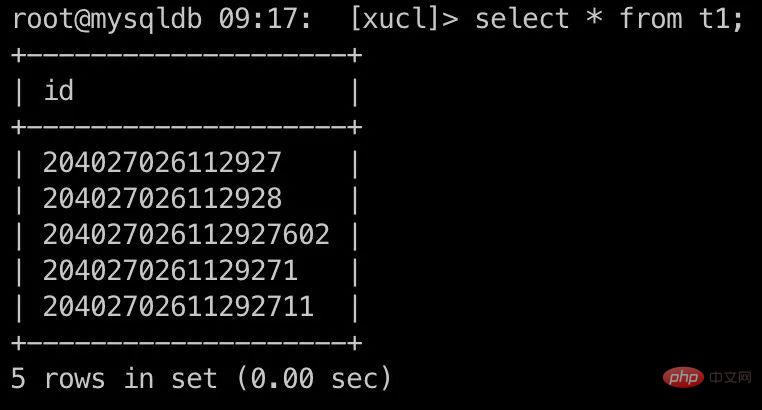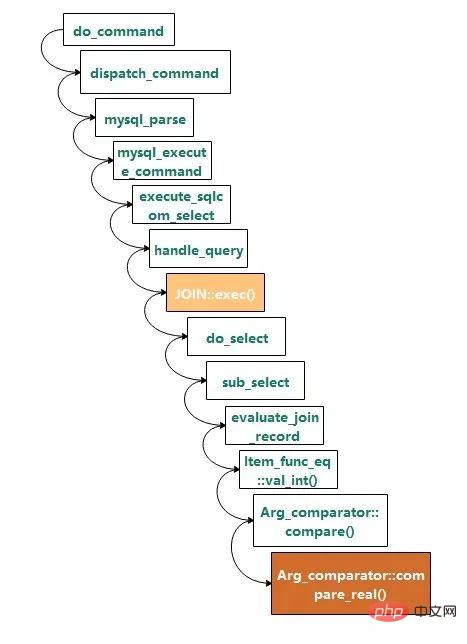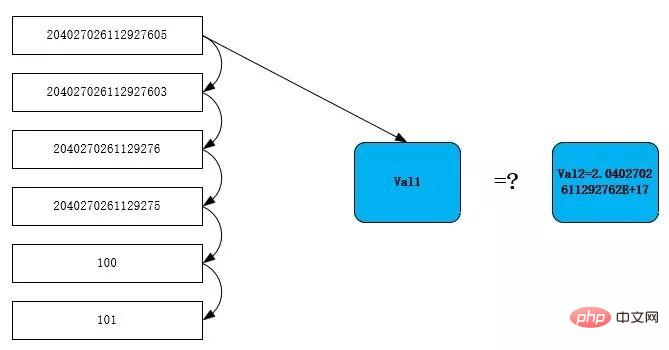 Datenbank
Datenbank
 MySQL-Tutorial
MySQL-Tutorial
 Werfen Sie einen Blick auf die erstaunlichen impliziten Konvertierungen von MySQL
Werfen Sie einen Blick auf die erstaunlichen impliziten Konvertierungen von MySQL
Werfen Sie einen Blick auf die erstaunlichen impliziten Konvertierungen von MySQL
In der Spalte „MySQL-Tutorial“ werden verwandte implizite Konvertierungen vorgestellt
一, Problembeschreibung
root@mysqldb 22:12: [xucl]> show create table t1\G
*************************** 1. row ***************************
Table: t1
Create Table: CREATE TABLE `t1` (
`id` varchar(255) DEFAULT NULL
) ENGINE=InnoDB DEFAULT CHARSET=utf8
1 row in set (0.00 sec)
root@mysqldb 22:19: [xucl]> select * from t1;
+--------------------+
| id |
+--------------------+
| 204027026112927605 |
| 204027026112927603 |
| 2040270261129276 |
| 2040270261129275 |
| 100 |
| 101 |
+--------------------+
6 rows in set (0.00 sec) Seltsames Phänomen: root@mysqldb 22:19: [xucl]> select * from t1 where id=204027026112927603;
+--------------------+
| id |
+--------------------+
| 204027026112927605 |
| 204027026112927603 |
+--------------------+
2 rows in set (0.00 sec)

Was zum Teufel? Es ist offensichtlich 204027026112927603, warum kam auch 204027026112927605 heraus? Zweitens: Erklärung des Quellcodes Die Anrufbeziehung ist wie folgt: Wo
JOIN::exec()ist der Einstiegspunkt für die Ausführung,Arg_comparator::compare_real()ist eine Funktion zur Äquivalenzbeurteilung und ihre Definition lautet wie folgtThe Die Vergleichsschritte lauten wie folgt: Wie in der Abbildung gezeigt, wird die ID-Spalte der T1-Tabelle Zeile für Zeile gelesen und in Val1 platziert. Die Konstante 204027026112927603 ist im Cache vorhanden und der Typ ist double (2.0402702611292762E+17), also danach Hier wird der Wert an val2 übergeben, val2=2.0402702611292762E+17 .int Arg_comparator::compare_real() { /* Fix yet another manifestation of Bug#2338. 'Volatile' will instruct gcc to flush double values out of 80-bit Intel FPU registers before performing the comparison. */ volatile double val1, val2; val1= (*a)->val_real(); if (!(*a)->null_value) { val2= (*b)->val_real(); if (!(*b)->null_value) { if (set_null) owner->null_value= 0; if (val1 < val2) return -1; if (val1 == val2) return 0; return 1; } } if (set_null) owner->null_value= 1; return -1; }Nach dem Login kopieren
Wenn die erste Zeile gescannt wird, beträgt der in ein Double umgewandelte Wert 2,0402702611292762e17. Es wird festgestellt, dass es sich um eine qualifizierte Zeile handelt. Ebenso ist 204027026112927603 konsistent ="rich_pages" src="https://img.php.cn/upload/article/000/000/052/7c4b6d4d87941f0fc37f0c115a3cf15e-3.jpg" alt="Werfen Sie einen Blick auf die erstaunlichen impliziten Konvertierungen von MySQL"/>So erkennen Sie das Konvertierung von String-Typ-Zahlen in Überläuft der Double-Typ?
Wenn die Zahl hier 16 Ziffern überschreitet, ist die Konvertierung in den Double-Typ nicht mehr korrekt



Die Definition der Konvertierung einer MySQL-Zeichenfolge in eine Double-Funktion lautet wie folgt:
{
char buf[DTOA_BUFF_SIZE];
double res;
DBUG_ASSERT(end != NULL && ((str != NULL && *end != NULL) ||
(str == NULL && *end == NULL)) &&
error != NULL);
res= my_strtod_int(str, end, error, buf, sizeof(buf));
return (*error == 0) ? res : (res < 0 ? -DBL_MAX : DBL_MAX);
}my_strtod_int befindet sich in dtoa.c (es ist zu kompliziert, posten Sie einfach eine Kommentar)/*
strtod for IEEE--arithmetic machines.
This strtod returns a nearest machine number to the input decimal
string (or sets errno to EOVERFLOW). Ties are broken by the IEEE round-even
rule.
Inspired loosely by William D. Clinger's paper "How to Read Floating
Point Numbers Accurately" [Proc. ACM SIGPLAN '90, pp. 92-101].
Modifications:
1. We only require IEEE (not IEEE double-extended).
2. We get by with floating-point arithmetic in a case that
Clinger missed -- when we're computing d * 10^n
for a small integer d and the integer n is not too
much larger than 22 (the maximum integer k for which
we can represent 10^k exactly), we may be able to
compute (d*10^k) * 10^(e-k) with just one roundoff.
3. Rather than a bit-at-a-time adjustment of the binary
result in the hard case, we use floating-point
arithmetic to determine the adjustment to within
one bit; only in really hard cases do we need to
compute a second residual.
4. Because of 3., we don't need a large table of powers of 10
for ten-to-e (just some small tables, e.g. of 10^k
for 0 <= k <= 22).
*/root@mysqldb 23:30: [xucl]> select * from t1 where id=2040270261129276; +------------------+ | id | +------------------+ | 2040270261129276 | +------------------+ 1 row in set (0.00 sec) root@mysqldb 23:30: [xucl]> select * from t1 where id=101; +------+ | id | +------+ | 101 | +------+ 1 row in set (0.00 sec)
root@mysqldb 22:19: [xucl]> select * from t1 where id='204027026112927603'; +--------------------+ | id | +--------------------+ | 204027026112927603 | +--------------------+ 1 row in set (0.01 sec)
sein. 3. Fazit

JOIN::exec()是执行的入口,Arg_comparator::compare_real()是进行等值判断的函数,其定义如下
1、If one or both arguments are NULL, the result of the comparison is NULL, except for the NULL-safe <=> equality comparison operator. For NULL <=> NULL, the result is true. No conversion is needed. 2、If both arguments in a comparison operation are strings, they are compared as strings. 3、If both arguments are integers, they are compared as integers. 4、Hexadecimal values are treated as binary strings if not compared to a number. 5、If one of the arguments is a TIMESTAMP or DATETIME column and the other argument is a constant, the constant is converted to a timestamp before the comparison is performed. This is done to be more ODBC-friendly. This is not done for the arguments to IN(). To be safe, always use complete datetime, date, or time strings when doing comparisons. For example, to achieve best results when using BETWEEN with date or time values, use CAST() to explicitly convert the values to the desired data type. A single-row subquery from a table or tables is not considered a constant. For example, if a subquery returns an integer to be compared to a DATETIME value, the comparison is done as two integers. The integer is not converted to a temporal value. To compare the operands as DATETIME values, use CAST() to explicitly convert the subquery value to DATETIME. 6、If one of the arguments is a decimal value, comparison depends on the other argument. The arguments are compared as decimal values if the other argument is a decimal or integer value, or as floating-point values if the other argument is a floating-point value. 7、In all other cases, the arguments are compared as floating-point (real) numbers.
比较步骤如下图所示,逐行读取t1表的id列放入val1,而常量204027026112927603存在于cache中,类型为double类型(2.0402702611292762E+17),所以到这里传值给val2后val2=2.0402702611292762E+17。

当扫描到第一行时,204027026112927605转成doule的值为2.0402702611292762e17,等式成立,判定为符合条件的行,继续往下扫描,同理204027026112927603也同样符合

如何检测string类型的数字转成doule类型是否溢出呢?这里经过测试,当数字超过16位以后,转成double类型就已经不准确了,例如20402702611292711会表示成20402702611292712(如图中val1)


MySQL string转成double的定义函数如下:
rrreee真正转换函数my_strtod_int Vermeiden Sie implizite Typkonvertierungen. Zu den Arten der impliziten Konvertierung gehören hauptsächlich inkonsistente Feldtypen. Der in-Parameter enthält mehrere Typen, Zeichensatztypen oder inkonsistente Sortierregeln usw.
Implizite Typkonvertierung kann dazu führen, dass sie nicht verwendet werden kann Indizes, ungenaue Abfrageergebnisse usw. müssen daher bei der Verwendung sorgfältig überprüft werden.
Es wird empfohlen, den numerischen Typ beim Definieren des Felds als int oder bigint zu definieren Es müssen die gleichen Typ-, Zeichensatz- und Sortierregeln beibehalten werden.
Bitte veröffentlichen Sie abschließend die Anweisungen zur impliziten Typkonvertierung von der offiziellen Website
Das obige ist der detaillierte Inhalt vonWerfen Sie einen Blick auf die erstaunlichen impliziten Konvertierungen von MySQL. Für weitere Informationen folgen Sie bitte anderen verwandten Artikeln auf der PHP chinesischen Website!

Heiße KI -Werkzeuge

Undresser.AI Undress
KI-gestützte App zum Erstellen realistischer Aktfotos

AI Clothes Remover
Online-KI-Tool zum Entfernen von Kleidung aus Fotos.

Undress AI Tool
Ausziehbilder kostenlos

Clothoff.io
KI-Kleiderentferner

AI Hentai Generator
Erstellen Sie kostenlos Ai Hentai.

Heißer Artikel

Heiße Werkzeuge

Notepad++7.3.1
Einfach zu bedienender und kostenloser Code-Editor

SublimeText3 chinesische Version
Chinesische Version, sehr einfach zu bedienen

Senden Sie Studio 13.0.1
Leistungsstarke integrierte PHP-Entwicklungsumgebung

Dreamweaver CS6
Visuelle Webentwicklungstools

SublimeText3 Mac-Version
Codebearbeitungssoftware auf Gottesniveau (SublimeText3)

Heiße Themen
 Wie verwende ich MySQL-Backup und -Wiederherstellung in PHP?
Jun 03, 2024 pm 12:19 PM
Wie verwende ich MySQL-Backup und -Wiederherstellung in PHP?
Jun 03, 2024 pm 12:19 PM
Das Sichern und Wiederherstellen einer MySQL-Datenbank in PHP kann durch Befolgen dieser Schritte erreicht werden: Sichern Sie die Datenbank: Verwenden Sie den Befehl mysqldump, um die Datenbank in eine SQL-Datei zu sichern. Datenbank wiederherstellen: Verwenden Sie den Befehl mysql, um die Datenbank aus SQL-Dateien wiederherzustellen.
 Wie optimiert man die MySQL-Abfrageleistung in PHP?
Jun 03, 2024 pm 08:11 PM
Wie optimiert man die MySQL-Abfrageleistung in PHP?
Jun 03, 2024 pm 08:11 PM
Die MySQL-Abfrageleistung kann durch die Erstellung von Indizes optimiert werden, die die Suchzeit von linearer Komplexität auf logarithmische Komplexität reduzieren. Verwenden Sie PreparedStatements, um SQL-Injection zu verhindern und die Abfrageleistung zu verbessern. Begrenzen Sie die Abfrageergebnisse und reduzieren Sie die vom Server verarbeitete Datenmenge. Optimieren Sie Join-Abfragen, einschließlich der Verwendung geeigneter Join-Typen, der Erstellung von Indizes und der Berücksichtigung der Verwendung von Unterabfragen. Analysieren Sie Abfragen, um Engpässe zu identifizieren. Verwenden Sie Caching, um die Datenbanklast zu reduzieren. Optimieren Sie den PHP-Code, um den Overhead zu minimieren.
 Wie füge ich mit PHP Daten in eine MySQL-Tabelle ein?
Jun 02, 2024 pm 02:26 PM
Wie füge ich mit PHP Daten in eine MySQL-Tabelle ein?
Jun 02, 2024 pm 02:26 PM
Wie füge ich Daten in eine MySQL-Tabelle ein? Mit der Datenbank verbinden: Stellen Sie mit mysqli eine Verbindung zur Datenbank her. Bereiten Sie die SQL-Abfrage vor: Schreiben Sie eine INSERT-Anweisung, um die einzufügenden Spalten und Werte anzugeben. Abfrage ausführen: Verwenden Sie die Methode query(), um die Einfügungsabfrage auszuführen. Bei Erfolg wird eine Bestätigungsmeldung ausgegeben.
 Wie erstelle ich eine MySQL-Tabelle mit PHP?
Jun 04, 2024 pm 01:57 PM
Wie erstelle ich eine MySQL-Tabelle mit PHP?
Jun 04, 2024 pm 01:57 PM
Das Erstellen einer MySQL-Tabelle mit PHP erfordert die folgenden Schritte: Stellen Sie eine Verbindung zur Datenbank her. Erstellen Sie die Datenbank, falls sie nicht vorhanden ist. Wählen Sie eine Datenbank aus. Tabelle erstellen. Führen Sie die Abfrage aus. Schließen Sie die Verbindung.
 Wie verwende ich gespeicherte MySQL-Prozeduren in PHP?
Jun 02, 2024 pm 02:13 PM
Wie verwende ich gespeicherte MySQL-Prozeduren in PHP?
Jun 02, 2024 pm 02:13 PM
So verwenden Sie gespeicherte MySQL-Prozeduren in PHP: Verwenden Sie PDO oder die MySQLi-Erweiterung, um eine Verbindung zu einer MySQL-Datenbank herzustellen. Bereiten Sie die Anweisung zum Aufrufen der gespeicherten Prozedur vor. Führen Sie die gespeicherte Prozedur aus. Verarbeiten Sie die Ergebnismenge (wenn die gespeicherte Prozedur Ergebnisse zurückgibt). Schließen Sie die Datenbankverbindung.
 So beheben Sie den Fehler „mysql_native_password nicht geladen' unter MySQL 8.4
Dec 09, 2024 am 11:42 AM
So beheben Sie den Fehler „mysql_native_password nicht geladen' unter MySQL 8.4
Dec 09, 2024 am 11:42 AM
Eine der wichtigsten Änderungen, die in MySQL 8.4 (der neuesten LTS-Version von 2024) eingeführt wurden, besteht darin, dass das Plugin „MySQL Native Password“ nicht mehr standardmäßig aktiviert ist. Darüber hinaus entfernt MySQL 9.0 dieses Plugin vollständig. Diese Änderung betrifft PHP und andere Apps
 Der Unterschied zwischen Oracle-Datenbank und MySQL
May 10, 2024 am 01:54 AM
Der Unterschied zwischen Oracle-Datenbank und MySQL
May 10, 2024 am 01:54 AM
Oracle-Datenbank und MySQL sind beide Datenbanken, die auf dem relationalen Modell basieren, aber Oracle ist in Bezug auf Kompatibilität, Skalierbarkeit, Datentypen und Sicherheit überlegen, während MySQL auf Geschwindigkeit und Flexibilität setzt und eher für kleine bis mittlere Datensätze geeignet ist. ① Oracle bietet eine breite Palette von Datentypen, ② bietet erweiterte Sicherheitsfunktionen, ③ ist für Anwendungen auf Unternehmensebene geeignet; ① MySQL unterstützt NoSQL-Datentypen, ② verfügt über weniger Sicherheitsmaßnahmen und ③ ist für kleine bis mittlere Anwendungen geeignet.
 So verwenden Sie bool in der C-Sprache
May 09, 2024 pm 01:00 PM
So verwenden Sie bool in der C-Sprache
May 09, 2024 pm 01:00 PM
Der Bool-Typ in der C-Sprache stellt wahr/falsch dar und der Wert ist 1 (wahr) oder 0 (falsch). Sie können bool is_true = true; verwenden, um boolesche Variablen zu deklarieren und zu initialisieren, oder Sie können das Schlüsselwort true/false verwenden. Bool-Variablen können logische NOT-, AND-, OR- und XOR-Operationen verwenden. Bool-Ausdrücke werden in bedingten Anweisungen und Schleifen verwendet. Der Typ bool kann implizit in den Typ int konvertiert werden (1: wahr, 0: falsch); der Typ int kann auch implizit in den Typ bool konvertiert werden (ungleich Null: wahr, 0: falsch).





